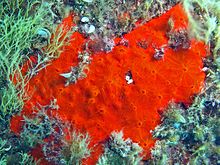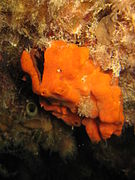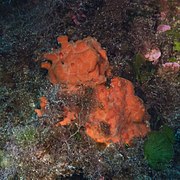| Crambe crambe | |
|---|---|

| |
| Crambe crambe from Elba | |
|
Scientific classification
| |
| Domain: | Eukaryota |
| Kingdom: | Animalia |
| Phylum: | Porifera |
| Class: | Demospongiae |
| Order: | Poecilosclerida |
| Family: | Crambeidae |
| Genus: | Crambe |
| Species: | C. crambe
|
| Binomial name | |
| Crambe crambe (
Schmidt, 1862)
| |
| Synonyms | |
|
List
| |
Crambe crambe, commonly known as the oyster sponge or orange-red encrusting sponge, is a species of demosponges belonging to the family Crambeidae. [1] [2]
The colonies of Crambe crambe form thin orange to orange-red plates, rarely lobed, with a very rough surface perforated by raised oscula found along the exhaling channels. These colonies can cover a surface of 1 m2. [3] [4]
Crambe crambe feeds by filtering bacteria, microorganisms and single-celled algae. This species is hermaphrodite. Larvae are planktonic. These demosponges often cover the shell of live shellfish ( Arca noae, Spondylus and various sedentary bivalves). Eupolymnia nebulosa sometimes hides itself on these sponges. [3]
This species is endemic to the Mediterranean, but it is also present in the North Atlantic Ocean, in the English Channel and in the North Sea. [3] [5] [6]
Crambe crambe commonly occurs in well-lit waters on hard substrate at depths of 5 to 30 m. [3]
-
Arca noae coveded by Crambe crambe
-
Eupolymnia nebulosa on Crambe crambe
-
Crambe crambe
- Babiç, K. 1922. Monactinellida und Tetractinellida des Adriatischen Meeres. Zoologische Jahrbücher. Abteilung für Systematik, Geographie und Biologie der Tiere 46(2): 217-302, pls 8-9.
- Barnes D.K.A.; Bell, J.J. (2002) Coastal sponge communities of the West Indian Ocean: taxonomic affinities, richness and diversity., Afr. J. Ecol. 40: 337-349
- Burton, M. (1956) The sponges of West Africa., Atlantide Report (Scientific Results of the Danish Expedition to the Coasts of Tropical West Africa, 1945-1946, Copenhagen) 4: 111-147.
- Lendenfeld, R. Von (1894) Die Tetractinelliden der Adria. (Mit einem Anhange über die Lithistiden)., Denkschriften der Kaiserlichen Akademieder Wissenschaften.Wien. Mathematisch-Naturwissenschaften Klasse 61: 91-204, pls I-VIII.
- Ben Mustapha, K.; Zarrouk, S.; Souissi, A.; El Abed, A. (2003). "Diversité des demosponges tunisiennes". Bull. Inst. Natn. Scien. Tech. Mer de Salanmbo (in French). 30. hdl: 1834/1077. ISSN 0330-0080.
- Pansini, M. (1987) Littoral demosponges from the banks of the Strait of Sicily and the Alboran Sea.,
- Sarà, M. (1960) Poriferi del litorale dell’isola d’lschia e loro ripartizioneper ambienti., Pubblicazioni della Stazione zoologica di Napoli 31(3):421-472, pls XII-XIII.
- Sarà, M.; Siribelli, L. (1960) La fauna di Poriferi delle ‘secche’ del Golfo di Napoli. 1. La ‘secca’ della Gaiola., Annuario dell’Istituto e Museo de Zoologia dell’Università di Napoli 12(3): 1-93.
- Schmidt, O. (1862) Die Spongien des adriatischen Meeres., (Wilhelm Engelmann: Leipzig): i-viii, 1-88, pls 1-7.
- Schmidt, O. (1864) Supplement der Spongien des adriatischen Meeres. Enthaltend die Histologie und systematische Ergänzungen., (Wilhelm Engelmann: Leipzig): i-vi, 1-48, pls 1-4.
- Topsent, E. (1892) Diagnoses d’éponges nouvelles de la Méditerranée et plus particulièrement de Banyuls., Archives de Zoologie expérimentale et générale (2) 10 (Notes et Revue 6) xvii-xxviii.
- Van Soest, R.W.M. (1990) Monanchora stocki n. sp. (Porifera, Poecilosclerida) from the Mid-Atlantic Islands., Bijdragen tot de Dierkunde 60 (3-4): 249-255
- Van Soest, R.W.M. (2001) Porifera, in: Costello, M.J. et al. (Ed.) (2001)., European register of marine species: a check-list of the marine species in Europe and a bibliography of guides to their identification. Collection Patrimoines Naturels, 50:
- Van Soest, R.W.M. (2002) Family Crambeidae Lévi, 1963.
- Vosmaer, G.C.J. (1880) The Sponges of the Leyden Museum. 1. The family of the Desmacidinae., Notes from the Leyden Museum 2: 99-164.
- ^ WoRMS
- ^ Catalogue of life
- ^ a b c d Doris - Données d'Observations pour la Reconnaissance et l'Identification de la faune et la flore Subaquatiques
- ^ Lawson Wood Sea Fishes Of The Mediterranean Including Marine Invertebrates
- ^ S. Duran, M. Pascual, X. Turon Low levels of genetic variation in mtDNA sequences over the western Mediterranean and Atlantic range of the sponge Crambe crambe (Poecilosclerida)
- ^ Duran S, Giribet G, Turon X. Phylogeographical history of the sponge Crambe crambe (Porifera, Poecilosclerida): range expansion and recent invasion of the Macaronesian islands from the Mediterranean Sea
| Crambe crambe | |
|---|---|

| |
| Crambe crambe from Elba | |
|
Scientific classification
| |
| Domain: | Eukaryota |
| Kingdom: | Animalia |
| Phylum: | Porifera |
| Class: | Demospongiae |
| Order: | Poecilosclerida |
| Family: | Crambeidae |
| Genus: | Crambe |
| Species: | C. crambe
|
| Binomial name | |
| Crambe crambe (
Schmidt, 1862)
| |
| Synonyms | |
|
List
| |
Crambe crambe, commonly known as the oyster sponge or orange-red encrusting sponge, is a species of demosponges belonging to the family Crambeidae. [1] [2]
The colonies of Crambe crambe form thin orange to orange-red plates, rarely lobed, with a very rough surface perforated by raised oscula found along the exhaling channels. These colonies can cover a surface of 1 m2. [3] [4]
Crambe crambe feeds by filtering bacteria, microorganisms and single-celled algae. This species is hermaphrodite. Larvae are planktonic. These demosponges often cover the shell of live shellfish ( Arca noae, Spondylus and various sedentary bivalves). Eupolymnia nebulosa sometimes hides itself on these sponges. [3]
This species is endemic to the Mediterranean, but it is also present in the North Atlantic Ocean, in the English Channel and in the North Sea. [3] [5] [6]
Crambe crambe commonly occurs in well-lit waters on hard substrate at depths of 5 to 30 m. [3]
-
Arca noae coveded by Crambe crambe
-
Eupolymnia nebulosa on Crambe crambe
-
Crambe crambe
- Babiç, K. 1922. Monactinellida und Tetractinellida des Adriatischen Meeres. Zoologische Jahrbücher. Abteilung für Systematik, Geographie und Biologie der Tiere 46(2): 217-302, pls 8-9.
- Barnes D.K.A.; Bell, J.J. (2002) Coastal sponge communities of the West Indian Ocean: taxonomic affinities, richness and diversity., Afr. J. Ecol. 40: 337-349
- Burton, M. (1956) The sponges of West Africa., Atlantide Report (Scientific Results of the Danish Expedition to the Coasts of Tropical West Africa, 1945-1946, Copenhagen) 4: 111-147.
- Lendenfeld, R. Von (1894) Die Tetractinelliden der Adria. (Mit einem Anhange über die Lithistiden)., Denkschriften der Kaiserlichen Akademieder Wissenschaften.Wien. Mathematisch-Naturwissenschaften Klasse 61: 91-204, pls I-VIII.
- Ben Mustapha, K.; Zarrouk, S.; Souissi, A.; El Abed, A. (2003). "Diversité des demosponges tunisiennes". Bull. Inst. Natn. Scien. Tech. Mer de Salanmbo (in French). 30. hdl: 1834/1077. ISSN 0330-0080.
- Pansini, M. (1987) Littoral demosponges from the banks of the Strait of Sicily and the Alboran Sea.,
- Sarà, M. (1960) Poriferi del litorale dell’isola d’lschia e loro ripartizioneper ambienti., Pubblicazioni della Stazione zoologica di Napoli 31(3):421-472, pls XII-XIII.
- Sarà, M.; Siribelli, L. (1960) La fauna di Poriferi delle ‘secche’ del Golfo di Napoli. 1. La ‘secca’ della Gaiola., Annuario dell’Istituto e Museo de Zoologia dell’Università di Napoli 12(3): 1-93.
- Schmidt, O. (1862) Die Spongien des adriatischen Meeres., (Wilhelm Engelmann: Leipzig): i-viii, 1-88, pls 1-7.
- Schmidt, O. (1864) Supplement der Spongien des adriatischen Meeres. Enthaltend die Histologie und systematische Ergänzungen., (Wilhelm Engelmann: Leipzig): i-vi, 1-48, pls 1-4.
- Topsent, E. (1892) Diagnoses d’éponges nouvelles de la Méditerranée et plus particulièrement de Banyuls., Archives de Zoologie expérimentale et générale (2) 10 (Notes et Revue 6) xvii-xxviii.
- Van Soest, R.W.M. (1990) Monanchora stocki n. sp. (Porifera, Poecilosclerida) from the Mid-Atlantic Islands., Bijdragen tot de Dierkunde 60 (3-4): 249-255
- Van Soest, R.W.M. (2001) Porifera, in: Costello, M.J. et al. (Ed.) (2001)., European register of marine species: a check-list of the marine species in Europe and a bibliography of guides to their identification. Collection Patrimoines Naturels, 50:
- Van Soest, R.W.M. (2002) Family Crambeidae Lévi, 1963.
- Vosmaer, G.C.J. (1880) The Sponges of the Leyden Museum. 1. The family of the Desmacidinae., Notes from the Leyden Museum 2: 99-164.
- ^ WoRMS
- ^ Catalogue of life
- ^ a b c d Doris - Données d'Observations pour la Reconnaissance et l'Identification de la faune et la flore Subaquatiques
- ^ Lawson Wood Sea Fishes Of The Mediterranean Including Marine Invertebrates
- ^ S. Duran, M. Pascual, X. Turon Low levels of genetic variation in mtDNA sequences over the western Mediterranean and Atlantic range of the sponge Crambe crambe (Poecilosclerida)
- ^ Duran S, Giribet G, Turon X. Phylogeographical history of the sponge Crambe crambe (Porifera, Poecilosclerida): range expansion and recent invasion of the Macaronesian islands from the Mediterranean Sea


